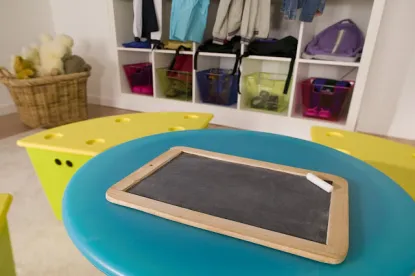The U.S. Department of Education (DOE) released new guidance on Aug. 24 related to school districts’ child find obligations during the pandemic as well as ongoing responsibilities to provide students with disabilities a Free and Appropriate Public Education (FAPE). The DOE also made clear its expectations that school districts open their doors to in-person learning for all students this school year. Key topics addressed include:
-
FAPE
-
Child Find
-
In-Person Learning
-
Funding Sources
We summarize the guidance and provide key takeaways below.
The guidance included a Letter from the Office of Special Education and Rehabilitation Services announcing their renewed commitment to serving children with disabilities and a separate Q&A addressing topics on child find. It also follows recent guidance on long COVID.
Full FAPE Obligations
Early guidance in 2020 from the US DOE made it clear that no IDEA requirements for school districts were waived as a result of the pandemic. This new guidance reiterates those same points: for the 2021-2022 school year, school districts remain obligated to provide FAPE to all students with disabilities. There is no new relief, waivers, or lessening of standards for school districts’ IDEA obligations to students with disabilities.
In-Person Learning
The DOE also took the opportunity to express its expectation that all school districts “provide every student with the opportunity for full-time, in-person learning for the 2021-2022 school year.” This expression does not carry any force of law or regulation but is an indication of how the current administration will approach future claims of denial of FAPE under either the IDEA or Section 504 when schools are not providing in-person learning opportunities. Of course, at the same time, the DOE also reiterated each district’s obligations to ensure learning environments are safe.
Child Find
The DOE is clearly signaling that child find will be an area of scrutiny moving forward. In addition to reiterating traditional child find obligations, the DOE also highlighted two areas in response to COVID-19:
-
Long COVID
-
Long-COVID or post-COVID conditions refer to new, returning, or ongoing health problems individuals experience more than four weeks after first being infected with COVID-19. Examples of symptoms can include fatigue, brain fog, headaches, dizziness, and shortness of breath.
-
School districts have child find obligations that include the identification of children suspected of having “long COVID” or suspected of having post-COVID conditions that meet the definition of a disability under the IDEA.
-
If students are already eligible for services and have long-COVID, then school districts have an obligation to determine if the student requires new or different related aids and services, specialized instruction, or reasonable modifications to their current IEP or 504 Plan.
-
Expansion of Child Find Procedures
-
In light of the COVID-19 pandemic, many students withdrew from traditional school districts and are currently enrolled in private schools or are homeschooled. School districts are still required to conduct child find activities to reach all students, even those that are attending private school and home school programs.
-
For students participating in virtual learning, school districts should consider that less face-to-face interaction with teachers and staff may impact observations of students’ learning abilities. School districts should beef up their child find procedures in these circumstances to ensure they are not solely relying upon parent referrals.
-
Examples of suggested child find activities include:
-
Awareness campaigns in multiple languages spoken within the community to target wide audiences, such as
-
Parents and families
-
Early childhood education providers
-
Daycares
-
Medical providers
-
Summer camps
-
Homeless shelters
-
Religious institutions
-
-
Developmental screening and information booths at locations frequented by children and families (public parks, shopping malls, children’s stores)
-
Locally administered assessments of student growth
-
Screening of private school and home school students
-
Meetings with mental health practitioners
-
Sharing information with nonprofits focused on children and families
-
Coordinating with state agencies
-
Collaboration with housing programs
-
Posting notices on school district websites and social media pages
-
Funding Sources
The DOE reminded school districts that funding for child find activities is available from the following sources:
-
IDEA Part B funds (regular IDEA Part B funds and additional IDEA Part B funds appropriated from the ARP Act)
-
Funds provides through the ESSER and GEER Funds
-
However, if a school district uses funds from its IDEA Part B allocations for child find activities for parentally-placed private school children, those expenses may not be used when determining if the school district has met requirements under 34 C.F.R. § 300.133(a) to spend a proportionate amount on the provision of special education and related services for parentally-placed children with disabilities attending private schools.
Examples of how school districts may choose to use these funds include:
-
conduct initial evaluations not timely completed due to COVID-19 complications;
-
hire additional special education staff;
-
contract with vendors for performing assessments;
-
train existing staff to conduct evaluations; or
-
upgrade assessment and evaluation tools for data calculations and report-writing.
School districts should use ARP Act funds to ensure health and safety of teachers, staff, and students when returning back to in-person learning.
Takeaways for School Districts
-
School districts are expected to utilize federal funds to provide all students with the opportunity to return to full-time, in-person instruction for the 2021-2022 school year. School districts are expected to to promote vaccination, along with universal mask-wearing to promote school-wide health and safety.
-
School districts must reassess their current community-wide child find procedures to ensure that they are applicable to the current environment, when so many families have pulled students out of school, privatizing or home schooling them. Relying on parental referral or a teacher’s in-person observation of a student will not be enough.
-
When a student’s lack of academic progress is attributed to limited instruction during the COVID-19 pandemic, then school districts should not automatically refer the student for an evaluation for special education services. The IDEA specifically states that a child may not be determined to be a child with a disability if the determinant factor is that the student lacks appropriate instruction in math and reading.
-
If a child has long-COVID or other post-COVID conditions that impacts their ability to participate in the general education curriculum, then the student must be referred for an evaluation for special education and related services.





 />i
/>i
